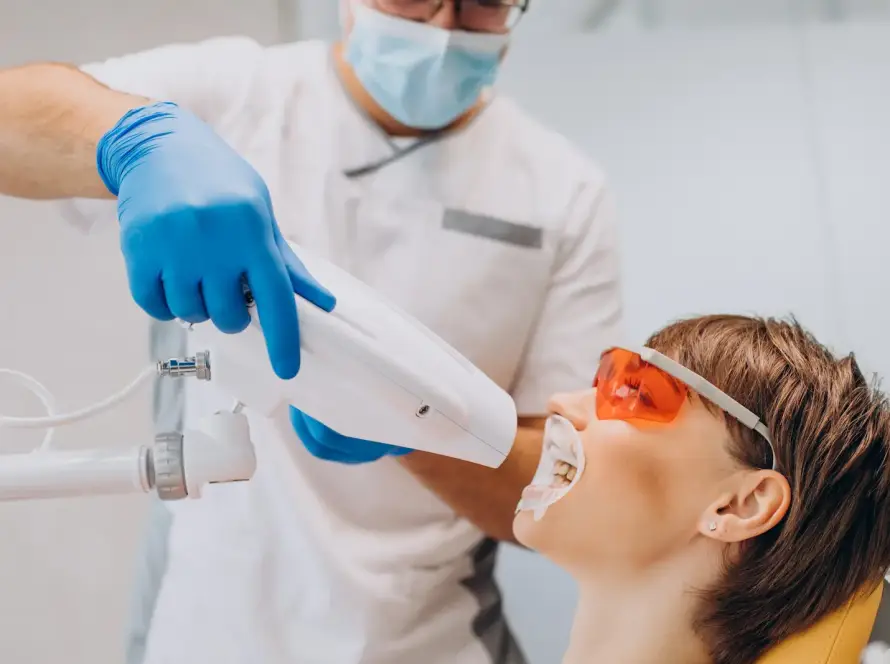The Healing Process After Tooth Extraction
After a tooth extraction, it is crucial to understand the healing process to ensure proper recovery. The extraction site goes through several stages of healing, which can take up to several weeks. Here is an overview of the healing process:
1. Blood clot formation: Immediately after the extraction, a blood clot forms in the socket. This clot is essential for protecting the underlying bone and nerves and promotes healing.
2. Socket healing: Over the next few days, the socket starts to heal by forming granulation tissue. This tissue helps in the formation of new bone and blood vessels.
3. Soft tissue healing: The surrounding gum tissues also play a vital role in the healing process. They gradually close and cover the extraction site, creating a protective barrier.
4. Bone remodeling: As time passes, the body starts to remodel the bone in the extraction area. This process can take several months to complete.
During the healing process, it is essential to take proper care of the extraction site to avoid any complications. Here are some helpful tips to ensure a smooth healing process:
1. Follow post operative instructions:
Your dentist will provide you with specific post operative instructions. It is crucial to follow them diligently, including any prescribed medications, oral rinses, and dietary restrictions.
2. Maintain oral hygiene:
Keep your mouth clean by gently brushing your teeth twice a day, avoiding the extraction site. Rinse your mouth with a saltwater solution (half teaspoon of salt dissolved in 8 ounces of warm water) after meals.
3. Avoid disturbing the extraction site:
To promote healing, avoid touching or probing the extraction site with your tongue or fingers. Don’t use a straw or spit forcefully, as it can dislodge the blood clot and delay healing.
4. Watch your diet:
Stick to soft foods for the first few days to avoid putting pressure on the extraction site. Avoid hot and spicy foods or anything that can cause irritation or discomfort.
5. Manage pain and swelling:
It is normal to experience some pain and swelling after tooth extraction. Apply an ice pack on the cheek outside the extraction area to help reduce swelling. Your dentist may prescribe pain medications if needed.
6. Attend follow up appointments:
Regularly attend follow up appointments with your dentist for them to monitor the healing progress and address any concerns or complications.
Remember, everyone’s healing process may vary. If you notice excessive bleeding, severe pain, pus, or persistent swelling, contact your dentist immediately. They will be able to evaluate the situation and provide the necessary treatment or guidance.
Foods to Avoid During the Initial Healing Period
During the initial healing period after a tooth extraction, it is essential to be cautious about the types of foods you consume. Avoiding certain foods can help prevent complications and promote faster healing. Here are some foods to avoid during this time:
1. Hard and crunchy foods: Foods that are hard and crunchy, such as nuts, chips, and hard candies, can potentially irritate the extraction site or dislodge the blood clot that forms in the socket. It is best to steer clear of these foods until your dentist gives you the green light.
2. Sticky and chewy foods: Sticky and chewy foods like caramel, chewing gum, and gummy candies can adhere to the extraction site and interfere with the healing process. They may also cause discomfort and increase the risk of infection. It is advisable to avoid these foods until the wound has sufficiently healed.
3. Spicy and acidic foods: Spicy and acidic foods can cause irritation and discomfort in the extraction site. Additionally, these foods may also delay the healing process or worsen any existing inflammation. It’s best to stay away from spicy dishes, citrus fruits, and acidic beverages for a few days.
4. Hot beverages: Hot beverages like coffee or tea can increase blood flow to the extraction site, leading to prolonged bleeding or the dislodgment of the blood clot. It is advisable to consume warm or cold beverages instead until the area has healed.
5. Carbonated drinks: Carbonated drinks, including soda and sparkling water, should be avoided during the initial healing period. The fizz in these beverages can create pressure in the mouth, potentially disturbing the blood clot or causing discomfort.
Soft and Easy to Eat Foods That are Safe After Tooth Extraction
After undergoing a tooth extraction, it is crucial to choose foods that are soft and easy to eat to avoid any potential discomfort or damage to the extraction site. Here are some safe food options that can provide the necessary nutrients while promoting healing:
1. Soups and broths: Warm, comforting soups and broths are great options as they are easy to consume and require minimal chewing. Opt for clear or pureed varieties such as vegetable, chicken, or bone broth.
2. Mashed potatoes: Soft and creamy mashed potatoes are gentle on the extraction site and provide a good source of carbohydrates. Avoid adding any crunchy toppings or spices that may cause irritation.
3. Yogurt and smoothies: Smooth and creamy yogurt is not only easy to eat but also provides essential proteins and probiotics. Additionally, nutrient rich smoothies made with soft fruits, yogurt, and protein powder can be a tasty and nourishing option.
4. Puddings and custards: These sweet treats offer a soft and smooth texture that is gentle on the extraction site. Opt for varieties without any hard or crunchy additives to prevent discomfort.
5. Soft cooked vegetables: Cooked vegetables such as carrots, peas, and broccoli can be softened to an easily chewable consistency. Be sure to avoid any tough or fibrous vegetables that may get lodged in the extraction site.
6. Eggs: Scrambled eggs or soft boiled eggs are excellent sources of protein and can be easily consumed without causing any discomfort. Be cautious of seasoning and ensure the eggs are not too hot.
7. Blended soups or smoothies with protein powder: Blending soft foods such as cooked vegetables or fruits with protein powder can provide a nutritious and easy to eat meal or snack option.
Remember to avoid any foods that are hard, chewy, or have small particles that can get stuck in the extraction site, such as nuts, seeds, popcorn, or chips. It is vital to prioritize soft foods during the healing process to allow for proper recovery and minimize the risk of complications. Always consult with your dentist or oral surgeon for specific recommendations based on your individual circumstances.
Importance of Proper Oral Hygiene During the Healing Process
Proper oral hygiene is of utmost importance during the healing process after a tooth extraction. It plays a crucial role in preventing complications such as infection and promoting faster healing. Here are some reasons why maintaining good oral hygiene is essential:
1. Preventing infection: After a tooth extraction, the open socket is vulnerable to bacteria and germs. Proper oral hygiene, including regular brushing and rinsing, helps to eliminate bacteria and reduce the risk of infection.
2. Stimulating blood circulation: Good oral hygiene practices, like gentle brushing, encourage blood circulation in the extraction site. This increased blood flow promotes faster healing and the formation of new tissues.
3. Removing food particles: Food particles can easily get stuck in the extraction hole, causing discomfort and increasing the likelihood of infection. Diligent brushing and flossing help remove these particles, preventing potential problems.
4. Reducing inflammation: Maintaining proper oral hygiene can help alleviate inflammation around the extraction site. Regular rinsing with warm saltwater can effectively soothe the area and reduce swelling.
5. Preventing dry socket: Dry socket, a painful condition that occurs when the blood clot in the extraction site becomes dislodged or dissolves, can be avoided with good oral hygiene. Following the dentist’s instructions on gentle brushing and avoiding strenuous activities can significantly reduce the risk of dry socket.
6. Promoting overall oral health: Practicing good oral hygiene habits during the healing process aids in fostering overall oral health. By keeping the surrounding teeth and gums clean, individuals can prevent further dental problems and maintain a healthy mouth.
In summary, proper oral hygiene is essential for a smooth healing process after a tooth extraction. It helps prevent infection, stimulates blood circulation, removes food particles, reduces inflammation, prevents dry socket, and promotes overall oral health. By following proper oral hygiene practices, individuals can ensure a quicker and more comfortable recovery.
Drinks to Consume for Hydration Without Risking Food Getting Stuck
When dealing with a tooth extraction hole, it is important to stay hydrated to aid in the healing process. However, it is crucial to choose beverages that will not cause any complications or risk food getting stuck in the extraction site. Here are some suitable drinks to consider:
1. Water: Water is always the best choice for hydration. It is tooth friendly, does not contain any sugars or acids, and will not cause any issues with food particles getting stuck in the extraction hole.
2. Clear broths and soups: Clear broths and soups are excellent options as they provide hydration and can be easily consumed without posing a risk of food debris getting lodged in the extraction site. Opt for broths or soups that do not contain any chewy or chunky ingredients.
3. Smoothies: Smoothies can be a great option, but it is essential to choose ones with a smooth consistency without any seeds or small fruit pieces. Be careful while using a straw, as it may cause suction that could dislodge the blood clot and hinder the healing process.
4. Herbal tea and decaf tea: Herbal tea or decaf tea can be soothing and hydrating. Opt for varieties without any loose leaves or small particles that may get stuck in the extraction hole. Avoid adding sugar or acidic additives to maintain oral health.
Remember to consume these drinks at a lukewarm or cool temperature, as hot or extremely cold beverages may cause discomfort or complications. Additionally, consult with your dentist for further guidance on safe drink choices during the healing period.
Using Natural Remedies to Promote Healing and Reduce the Risk of Food Getting Stuck
When dealing with a tooth extraction hole, natural remedies can be effective in promoting healing and reducing the risk of food getting stuck. Here are some remedies to consider:
1. Saltwater rinse: Gently rinsing your mouth with warm saltwater can help cleanse the extraction site and promote healing. Mix a teaspoon of salt in a cup of warm water and swish it around your mouth for about 30 seconds before spitting it out. Repeat this a few times a day.
2. Clove oil: Clove oil has natural antibacterial properties and can help alleviate pain and reduce inflammation. Apply a small amount of clove oil to a cotton ball and gently dab it on the extraction site. Be careful not to apply too much pressure.
3. Cold compress: If you experience swelling around the extraction site, applying a cold compress can help reduce inflammation. Place a cold pack or a bag of frozen vegetables wrapped in a thin cloth on the affected area for 10-15 minutes at a time.
4. Soft diet: Stick to soft foods that are easier to chew and less likely to get stuck in the extraction site. Opt for soups, mashed potatoes, yogurt, smoothies, and cooked vegetables. Avoid hard and sticky foods that can irritate the wound.
5. Gentle brushing: Brushing your teeth gently is essential to maintain oral hygiene and prevent food particles from getting stuck. Use a soft bristle toothbrush and be extra careful around the extraction site. Avoid vigorous rinsing and spitting, as it may dislodge the blood clot.
Remember, while natural remedies can provide temporary relief and aid in healing, it’s important to follow your dentist’s advice and attend follow up appointments. If you experience severe pain, prolonged bleeding, or any concerns, contact your dentist immediately.
Signs of Infection to Watch Out For
After a tooth extraction, it is important to keep a close eye on the healing process to ensure there are no signs of infection. Infections can occur if bacteria enter the extraction site, leading to complications and discomfort. Here are some signs of infection to watch out for:
1. Increased pain: While some discomfort is normal after a tooth extraction, an increase in pain that is persistent and worsening may indicate an infection. If the pain becomes unbearable or does not subside with over the counter pain medication, it is essential to seek immediate dental attention.
2. Swelling: Swelling around the extraction site is expected within the first few days, but if the swelling continues to increase or persists beyond a week, it might be a sign of infection. Additionally, if the swelling is accompanied by a foul taste or odor, it is crucial to consult a dentist.
3. Redness and warmth: If the area surrounding the extraction site appears red and feels warm to the touch, it may indicate an infection. These signs can be an indication that the body is responding to an infection and trying to fight it off. It is advisable to seek dental advice promptly if these symptoms are present.
4. Pus or discharge: Any unusual discharge, such as pus or fluid, coming from the extraction site is a strong indicator of infection. Pus is a sign that the body is attempting to fight off bacteria or other foreign substances. If you notice pus or any other abnormal discharge, it is essential to notify your dentist immediately.
5. Fever: Developing a fever after a tooth extraction can be an indication of infection. If your body temperature exceeds 100.4°F (38°C), it is crucial to contact your dentist as soon as possible. A fever, along with other symptoms mentioned above, can be signs of a more severe infection.
6. Bad breath or taste: Persistent bad breath or an unpleasant taste in the mouth may be an indication of infection. Bacteria can thrive in the extraction site, leading to the release of foul odor or taste. If these symptoms persist despite proper oral hygiene, it is important to consult a dental professional.
Remember, it is essential to address any signs of infection promptly to avoid potential complications. If you experience any of these symptoms after a tooth extraction, contact your dentist for an evaluation and appropriate treatment.
The Importance of Follow Up Care With Your Dentist
After undergoing a tooth extraction, it is crucial to prioritize follow up care with your dentist. While the extraction procedure itself may remove the troublesome tooth, proper aftercare is necessary to ensure a successful healing process. Regular check ups with your dentist allow them to monitor your progress and address any potential complications that may arise.
Here are some reasons why follow up care is essential:
1. Monitoring recovery: Regular visits to your dentist enable them to monitor the healing progress of the extraction site. They can assess whether the socket is closing properly, check for infections, and ensure that the surrounding tissues are healing as expected.
2. Addressing complications: In some cases, complications may arise after a tooth extraction, such as dry socket, infection, or delayed healing. Timely follow up appointments allow your dentist to identify and address these issues promptly. Early intervention can prevent further discomfort and complications down the line.
3. Optimizing oral health: Following a tooth extraction, your dentist can provide guidance on maintaining good oral hygiene during the healing process. They may recommend special care instructions, such as avoiding certain foods or using a saltwater rinse. Regular check ups allow your dentist to assess your overall oral health and provide personalized recommendations.
4. Preventing future problems: Your dentist can use follow up appointments as an opportunity to discuss any concerns or questions you may have. They can provide guidance on oral hygiene practices, suggest preventive measures for future oral health issues, and address any potential risk factors.
5. Proper removal of sutures: If sutures were used to close the extraction site, they will need to be removed at the appropriate time. Your dentist will determine when to remove them based on the healing progress. This step is important to ensure that the gums heal properly and to prevent any further complications.
By attending follow up appointments, you are actively participating in your oral health care and ensuring a smooth recovery process. Don’t hesitate to reach out to your dentist if you experience any abnormal symptoms or have any questions during your recovery period. Remember that their expertise and guidance are invaluable in promoting optimal healing and maintaining your overall oral health.
Long Term Dietary Considerations for Oral Health
Maintaining good oral health is not just about taking care of your teeth and gums; it also involves making healthy dietary choices. What you eat can significantly impact the health of your teeth and gums in the long term. Here are some important dietary considerations to keep in mind for optimal oral health:
1. Limit sugary foods and drinks:
Consuming excessive amounts of sugary foods and drinks can promote the growth of harmful bacteria that cause tooth decay. Limit your intake of sweets, sodas, juices, and other sugary beverages. Opt for water or unsweetened drinks whenever possible.
2. Choose tooth friendly snacks:
Instead of reaching for sugary snacks, opt for healthy alternatives such as fruits, vegetables, nuts, and yogurt. These snacks are not only nutritious but also promote saliva production, which helps rinse away food particles and neutralize acids in the mouth.
3. Include calcium rich foods:
Calcium is essential for strengthening teeth and bones. Ensure that your diet includes calcium rich foods like dairy products (milk, cheese, yogurt), leafy greens (spinach, kale), almonds, and tofu.
4. Maintain proper hydration:
Drinking an adequate amount of water throughout the day is crucial for oral health. Water helps wash away food particles, stimulates saliva production, and keeps the mouth moist, reducing the risk of tooth decay.
5. Avoid sticky foods:
Sticky foods, such as caramel, toffees, and dried fruits, tend to cling to the surfaces of teeth, making it difficult to remove them through regular brushing. These foods can increase the risk of tooth decay and dental plaque formation.
6. Stay away from acidic foods:
Acidic foods and beverages, like citrus fruits, tomatoes, and carbonated drinks, can erode the enamel on your teeth over time. Limit your consumption of acidic foods and rinse your mouth with water afterward to minimize their effects.
7. Practice proper dental hygiene:
While maintaining a healthy diet is essential, it should not replace regular dental hygiene practices. Be sure to brush your teeth at least twice a day, floss daily, and visit your dentist for regular check ups and cleanings.
By following these long term dietary considerations, you can significantly improve your oral health and reduce the risk of dental problems. Remember, a healthy diet combined with good oral hygiene practices is the key to maintaining a bright and healthy smile.















